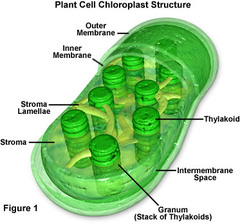Biology Quiz (notes 9.1-9.2)
0.0(0)
Card Sorting
1/31
Study Analytics
Name | Mastery | Learn | Test | Matching | Spaced |
|---|
No study sessions yet.
32 Terms
1
New cards
Structure of Chloroplasts
outer membrane, inner membrane, Thylakoid w/ chlorophyll, grana, & stroma

2
New cards
Chlorophyll
Green pigment in plants that absorbs light energy used to carry out photosynthesis
3
New cards
Chlorophyll a
absorbs more blue light
4
New cards
Chlorophyll b
absorbs more red light
5
New cards
Cartenoids
includes yellow, orange, & brown pigments; allows plant to absorb more of the sun's energy
6
New cards
2 parts of photosynthesis
light dependent and light independent
7
New cards
Light dependent Reactions
Occurs in Thylakoid (membrane), converts light energy to chemical energy (ATP)
8
New cards
Photosystems I & II
clusters of pigments arranged in the thylakoid
9
New cards
stages of light dependent reactions
1: light energy is absorbed, electrons are energized, water is split
2: H+ concentration is high and diffuse across thylakoid membrane, movement triggers formation of ATP (phosphorylation)
2: H+ concentration is high and diffuse across thylakoid membrane, movement triggers formation of ATP (phosphorylation)
10
New cards
Phosphorylation
when a P is bonded with ADP, making ATP
11
New cards
1st Process of light dependent reactions
light enters the leaf & is absorbed by the photosystems
12
New cards
2nd Process of light dependent reactions
Water is taken into the leaf & "split" in PS2
equation: 2(H2O) ==> 4(H+) + 4(e-) + O2
equation: 2(H2O) ==> 4(H+) + 4(e-) + O2
13
New cards
3rd Process of light dependent reactions
oxygen that came from the breakdown of water is released into the atmosphere (function of oxygen is for cellular respiration)
14
New cards
4th Process of light dependent reactions
electrons in the chlorophyll molecules absorb the energy (source of electrons is water)
15
New cards
5th Process of light dependent reactions
as electrons are passed along (by the electron transport chain), the energy is released to form NADPH
16
New cards
Inputs of Light dependent reactions
H2O & Light
17
New cards
Outputs of Light dependent reactions
O2, NADPH, & ATP
18
New cards
Stomata
microscopic openings in the epidermis of the leaf
19
New cards
Transpiration
process by which water vapor leaves the plant through the stomata in the leaves
20
New cards
Light Independent Reactions
AKA: Calvin-Benson cycle, Calvin cycle; occurs in the stroma, carbon fixation
21
New cards
Carbon fixaton
carbon atoms from CO2 are bonded into organic compounds (sugars)
22
New cards
Step 1 of light independent reactions (the Calvin Cycle)
an enzyme combine CO2 with RuBP and results in the formation of PGA
23
New cards
RuBP
a five-carbon carbohydrate
24
New cards
PGA
a six-carbon molecule that splits into a pair of 3 carbon molecules; pair of 3 carbon molecules
25
New cards
Step 2 of light independent reactions (the Calvin Cycle)
PGA receives a phosphate from ATP and a proton from NADPH which results in ADP & NADP+ (these are then recycled)
26
New cards
Step 3 of light independent reactions (the Calvin Cycle)
The resulting PGAL are either used:
-by the plant cell to make other organic compounds
(one of the 6 molecules of PGAL is transferred to the cytoplasms and used in the synthesis of sugars & and other carbs)
-to regenerate the 5 carbon compound from step 1: RuBP (requires more ATP)
-by the plant cell to make other organic compounds
(one of the 6 molecules of PGAL is transferred to the cytoplasms and used in the synthesis of sugars & and other carbs)
-to regenerate the 5 carbon compound from step 1: RuBP (requires more ATP)
27
New cards
Inputs of light independent reactions/ Calvin cycle
NADPH, ATP, CO2
28
New cards
Outputs of light independent reactions/calvin cycle
sugars
29
New cards
White light
all colors of the rainbow
30
New cards
Best light color to absorb in plants
blue & red
31
New cards
Worst light color to absorb in plants
green (it's going to be reflected so no light is absorbed)
32
New cards
Environmental Factors that affect photosynthesis
light intensity, carbon dioxide, amount of water, temperature, humidity, oxygen